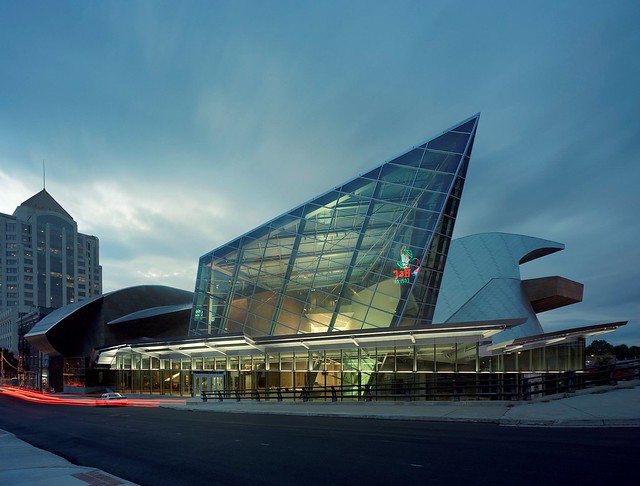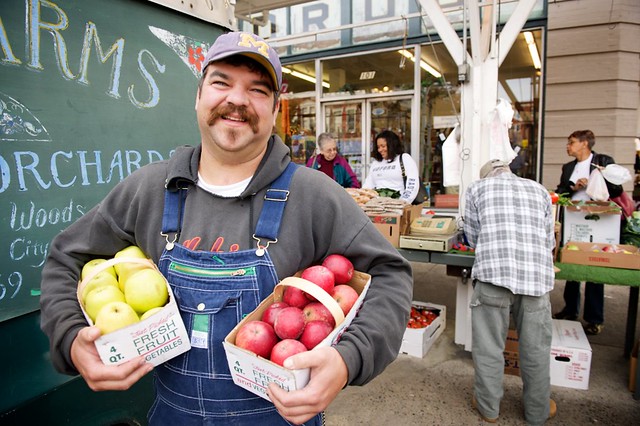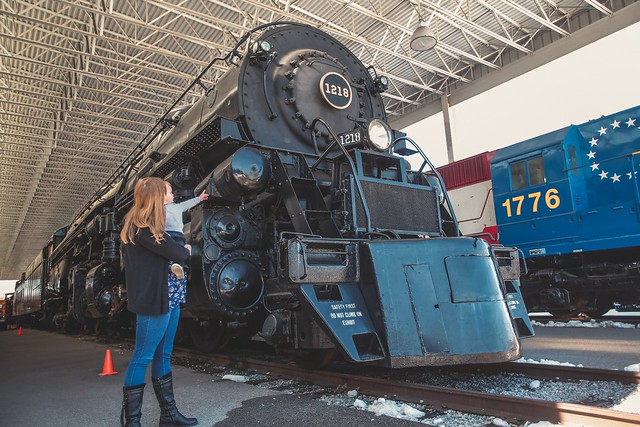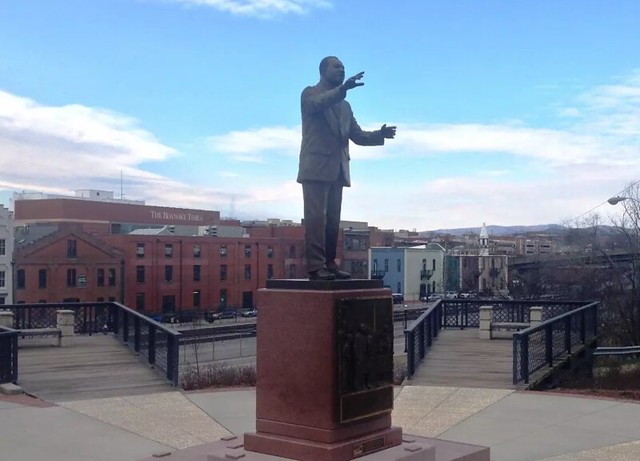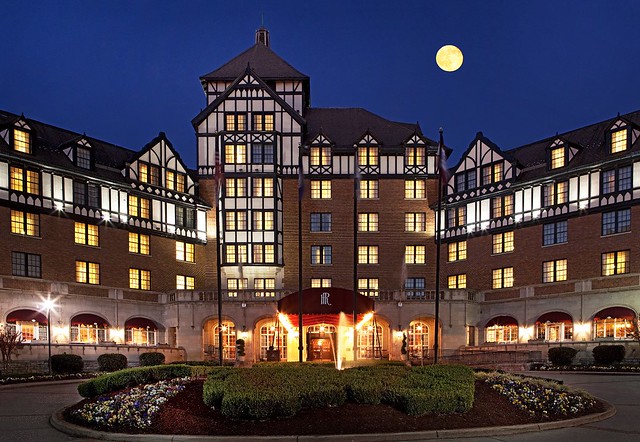Founded as a railroad town, the region still celebrates its unique railroad history and heritage.
-
Things To Do
- Arts & Culture
- Attractions
- Beer, Wine & Spirits
- Blue Ridge Parkway
- Events
- Free Things To Do
- History & Heritage
- Kid Friendly
- Nightlife
-
Outdoor Adventure
- Leave No Trace
- Trail Guidelines
- Appalachian Trail
- Biking
- Climbing
- Disc Golf
- Fall Color Spots
- Fishing
- Geocaching
- George Washington & Jefferson National Forests
- Greenways
- Hiking Trails
- Horseback Riding
- Kayaking & Paddling
- Kid Friendly Outdoors
- Motorcycle Touring
- Outdoor Outfitters & Shops
- Scenic Drives
- Water Sports
- Wildlife Viewing & Birding
- Classes & Workshops
- Sample Itinerary
- Sample Itineraries
- Shopping
- Spas
- Sports
- Tours
- VBR Savings Pass
- Hotels/Lodging
- Restaurants
- Region
- Plan
Downtown Roanoke Walking Tour
Downtown Roanoke is the historic center of the City of Roanoke and home to many popular amenities and attractions.
This walking tour provides the opportunity to see a variety of historic buildings, art, and architecture, which is evident on every corner.
Former N&W Railway Passenger Station - 1905
The former passenger train station was remodeled in 1949 by renowned industrial designer Raymond Loewy. The last passenger train stopped at the station in 1971, which is now home to the Virginia's Blue Ridge Visitor Information Center and O. Winston Link Museum.
Taubman Museum of Art - 2008
This striking marvel of modern architecture is one of the premier art museums in Virginia and boasts a variety of permanent collections and temporary exhibits.
Dog Mouth Fountain - 1898
Legend has it that whoever drank from this fountain would always return to Roanoke. Horses would drink from the street side while people drank from the dog's mouth. It's located beside the Wells Fargo Tower building, which dominates the city skyline with its copper rooftop.
City Market Building - 1922
This iconic facility originally served as a marketplace where meatcutters offered their products in various stalls. It now serves as multicultural food court with a variety of local restaurants.
McGuire Building & Center in the Square - 1914
Built to house W.E. McGuire's Farmer's Supply Co., which sold buggies, wagons, seed, and other farm products, this building is now home to Center in the Square. The center features multiple museums, aquariums, and many things that make it a must-stop during your tour of Downtown Roanoke.
Historic Roanoke City Market - 1882
As one of the oldest markets in Virginia, it's a great place to browse local produce, plants, and handmade crafts. And don't miss the unique architecture of the buildings along Market Street.
Fire Station #1 - 1906
This classic fire station has a facade that was loosely modeled after Independence Hall in Philadelphia. The interior was constructed for the era of horse-drawn fire wagons and the original brass poles and tin ceiling still exist today.
Friendship Fountain - 1987
This fountain recognizes Roanoke's seven Sister Cities around the world. The pool is lined with historic bricks that were used on the city's early streets.
Kimball Fountain - 1907
A red granite monument that serves as a tribute to Frederick J. Kimball, who served as President of the Norfolk & Western Railway and helped establish Roanoke as the railroad's headquarters.
Elmwood Park - 1982
Renovated in 2013, Elmwood Park features fountains and a collection of art pieces while also being one of the premier outdoor event venues in Virginia's Blue Ridge.
City of Roanoke Main Public Library & Virginia Room - 1951
The recently renovated Public Library is a wonderful place to take kids, and the Virginia Room has many amazing artifacts and archives relating to the region's history.
Commercial Brick Signage
Many early businesses advertised with painted signage on building facades, and some of those signs can still be seen today on Church Avenue. The iconic "Uneeda Biscuit" sign is a popular photo spot in Downtown Roanoke.
Texas Tavern - 1930
One of the iconic landmarks of the Roanoke Valley, this classic restaurant is open 24-hours-a-day and is famous for its "chile" and "Cheesy Western" burger.
Greene Memorial United Methodist Church - 1902
A Gothic style church with a prominent bell tower that rests on footings as deep as the tower because of the limestone spoil and caverns underneath.
Noel C. Taylor Municipal Building - 1971
The building that houses various city departments is named after Roanoke's first African American mayor. It adjoins the gorgeous Neoclassical Revival municipal building (1915) that faces Campbell Avenue.
Norfolk & Western Railway Freight Station & Virginia Museum of Transportation - 1918
This station served as the hub of freight operations for much of the country in the 20th century. In 1986, it became home to the Virginia Museum of Transportation, which boasts an incredible collection of locomotives.
Hancock Building - 1920s
This striking art deco building was originally the location of a dry goods firm. After being damaged by multiple fires in the 1930s, the exterior was covered for many years before eventually being restored to its original art deco splendor.
Martin Luther King Jr. Memorial Bridge - 2008
The steel truss bridge was constructed by the Norfolk & Western Railway in 1891, but restored in 2008 as a walkway with a memorial plaza and statue that honors Dr. Martin Luther King Jr.
Dumas Hotel - 1916
Formerly known as the Hotel Hampton, which served African Americans during the days of segregation. It was known for holding informal late-night concerts with many world-renowned African American jazz musicians who would perform in the city and stay at the hotel.
Ebony Club - 1920s
Formerly the Lincoln and Strand Theatres, it was a theatre and nightclub that served the African American community. Nationally-known film producer Oscar Micheaux had an office at the theatre.
Norfolk & Western Railway Office Building - Roanoke Higher Education Center - 1930s
This location served as the N&W Railway headquarters for more than 50 years, and it now serves as an institutional space for 16 area colleges and universities, as well as residential apartments.
Historic Gainsboro - 1834
One of the original settlements of the area that became the African American community during segregation. Patton & Gilmer Avenues now serve as the residential historic district.
Gainsboro Library - 1940
The land for the library was gifted to the city after Virginia Lee, a Gainsboro resident, wrote a letter to the Catholic church in Rome. The priest agreed to the request and also received approval from Pope Pius XII. Lee served as the librarian for 43 years.
St. Andrew's Catholic Church - 1902
One of the state's leading examples of High Victorian Gothic Architecture, the church still serves as an iconic symbol of the city skyline. The dramatic interior of the church features vaulting, carving, stenciling, and stained glass.
The Hotel Roanoke & Conference Center - 1882
This half-timbered Tudor revival hotel was constructed and operated by Norfolk & Western Railway for over 100 years. Recognized as a local landmark, it was donated to Virginia Tech in 1989 and restored to its original beauty, along with a state-of-the-art conference center.
To help navigate while you're downtown, we also offer a downloadable PDF of this walking tour.
In This Section
Want the latest on Virginia’s Blue Ridge? Securely sign up for our FREE e-newsletter:
Visit Virginia's Blue Ridge 101 Shenandoah Avenue NE Roanoke, VA 24016 (540) 342-6025 (800) 635-5535
Visit Virginia’s Blue Ridge is committed to cultivating an atmosphere that welcomes and celebrates the unique backgrounds, abilities, passions, and perspectives of our vibrant community. As our region’s only destination marketing organization, we have a responsibility to showcase the best the Roanoke Region has to offer, and those assets and strengths come in varied forms. We embrace differences in race, religion, sexual orientation, gender, gender identity or expression, language, visible and invisible disabilities, and all the intersecting identities that make Virginians and visitors alike so unique. We believe our differences make us stronger– and better.


